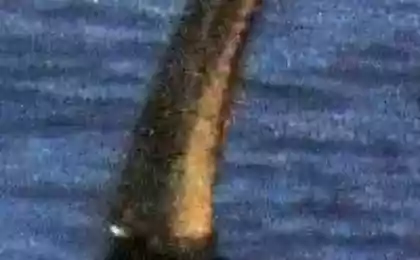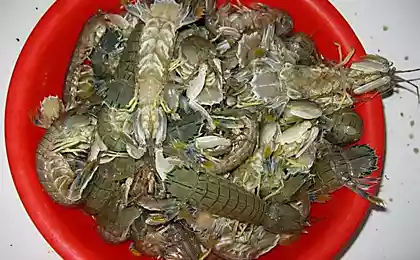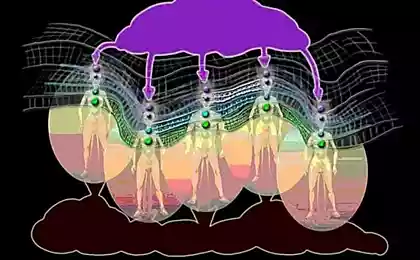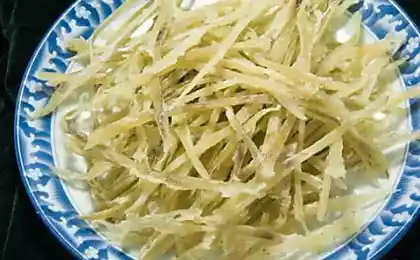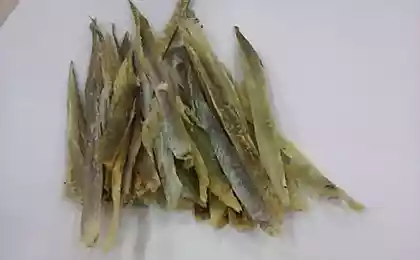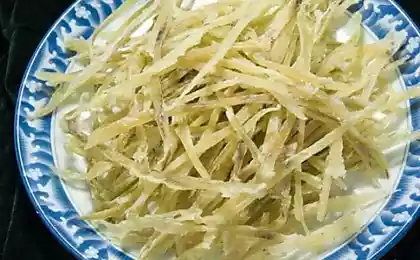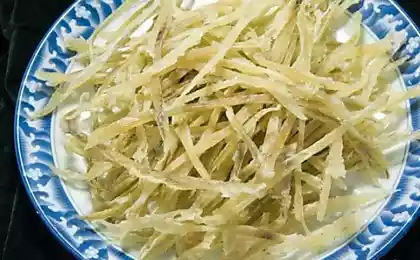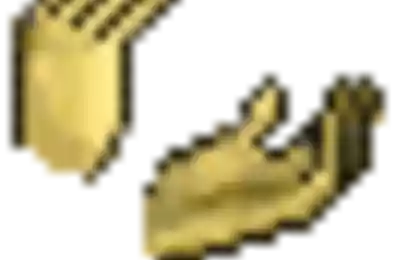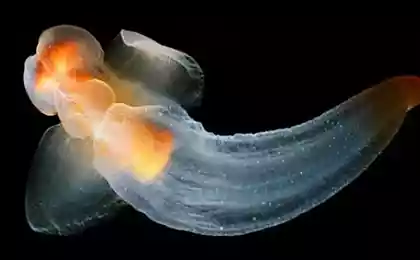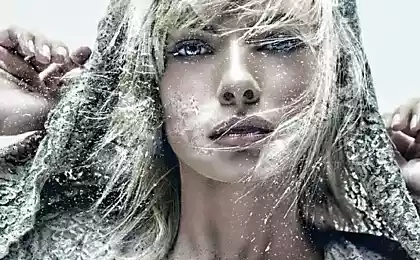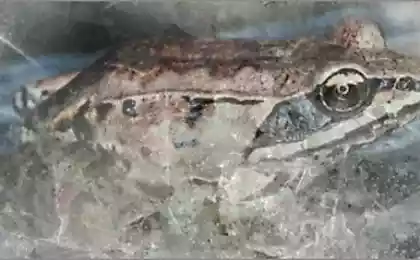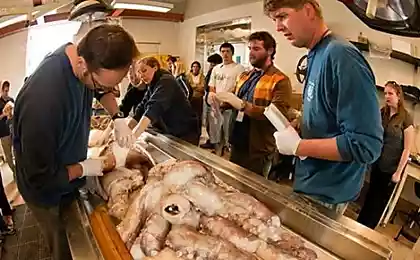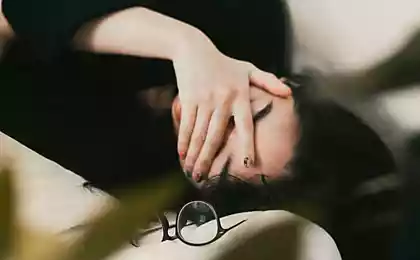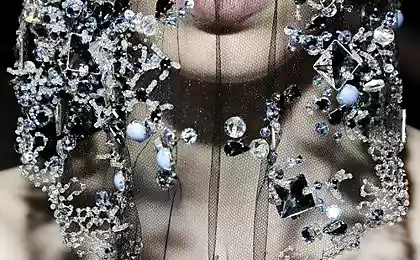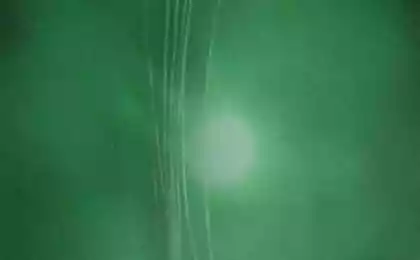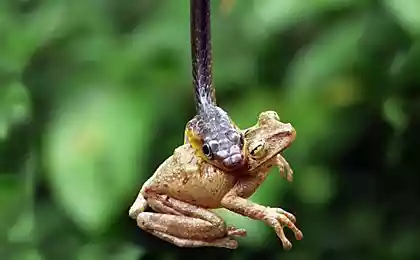1216
Vampire squid or a hellish vampire squid
Writes Helga:
Today I want to introduce you to one small cephalopods, wearing frightening name "vampire squid". For what it so to be honest, I still do not understand. This animal is unique in every way. Take, for what he has blue blood, and it can easily be at a depth of 400 to 1,000 meters, where oxygen content is minimal.
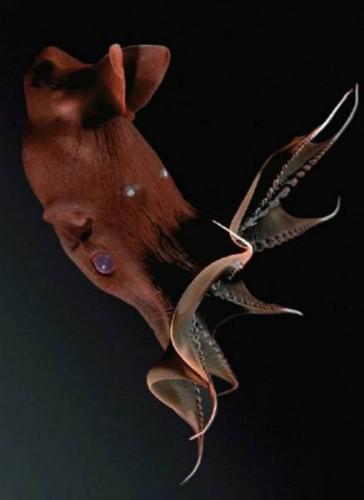
Vampire squid or a hellish vampire squid (lat. Vampyroteuthis infernalis) (Eng. Vampire Squid)
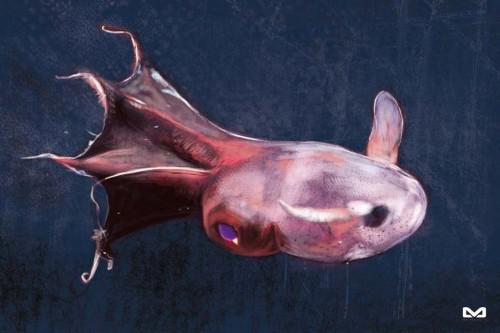
The discovery of this animal belongs to the German zoologist Karl Hun, I discovered it in 1903. This deep-water clam has common features with the octopus and squid. Initially, it wrongly attributed to the octopus. Although over time it became clear that it is necessary to allocate a separate unit, which was named Varpyromorhida.
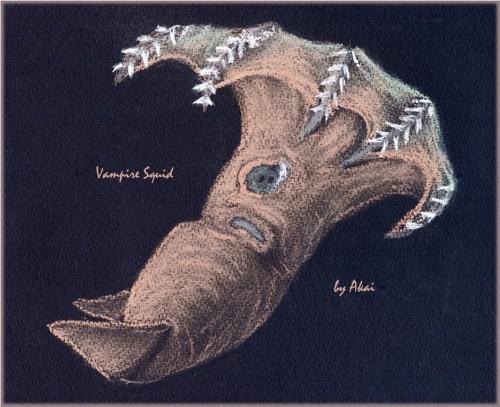
In the area of its habitat no light penetrates. At this depth is a special habitat, which was called "the oxygen minimum zone." It is very low oxygen concentration. But the vampire squid conditions are quite comfortable. He can live with 3% concentration of oxygen in the water. In such a feat by any other animal can not.
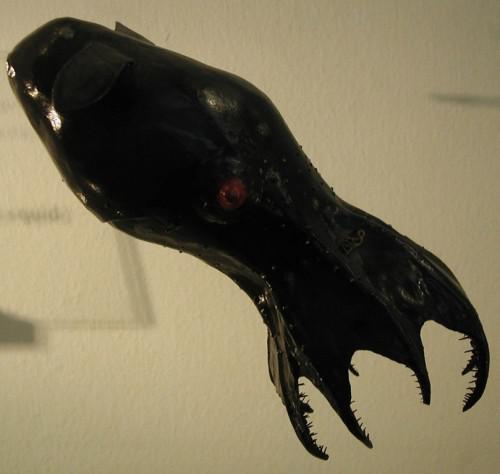
Rostochkom vampire came out - just 15 centimeters, but argue that it can grow up to 30 centimeters. A couple of little "devil incarnate." Its gelatinous body is able to change color depending on the light. He may become black, dark purple, red, brown.
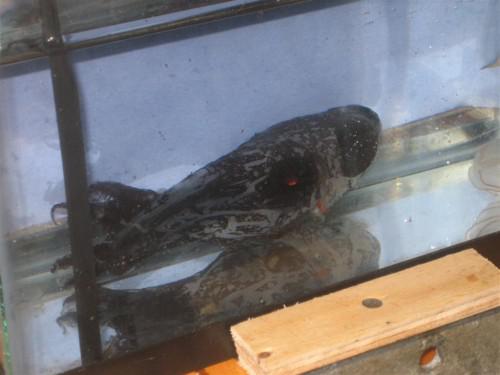
At the vampire squid has eight tentacles that are interconnected membranes. Each of them is covered with needles inside and mustache. Under certain circumstances, the squid uses them very skillfully. How? Learn dalshe.Na ends of tentacles arranged sucker.
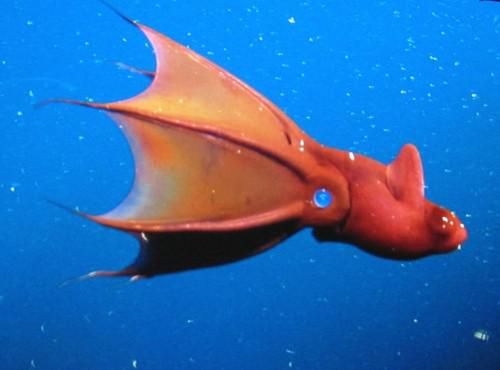
In vampire squid unusual bulging eyes. Like skin, they can change their color depending on the light (in red or blue). Right chameleon deep sea world. The diameter of the eye is 2, 5 cm. When compared with the total length of the body, they are the large eyes in proportion to body size among all animals. They are hypersensitive and are able to discern the silhouettes of other animals, floating on top. And do it in almost total darkness is not so simple.
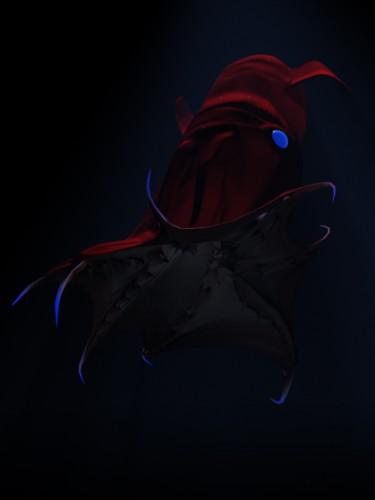
If you look closely, you'll see a pair of "ears". This fins, growing out of the side parts of the mantle. They are the main means of transportation in adults.
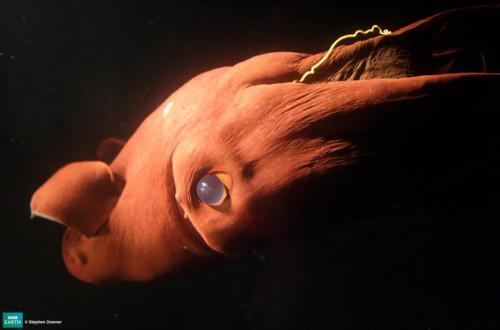
The connective tissue in the area of the tentacles are 2 bags, hiding sensitive velar flagella. These then are the true "tentacles" vampire, because they can stretch the farthest tentacles
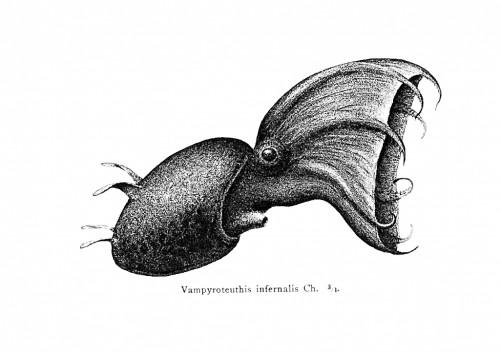
Vampire squid can glow in the dark. His entire body surface is covered with photophores - bodies glow. They are small wheels, which increase at the base of the fins and at the ends of the tentacles. But on the inside of the membranes and they are not for a reason, which I'll discuss below.
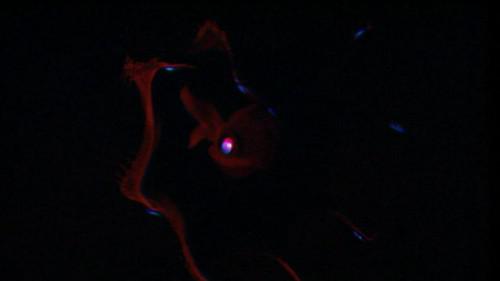
Its glow he skillfully uses as a defense against attackers. Squid produces flashes of light that disorient the enemy. It can control the size of the light spots and the brightness of their glow.
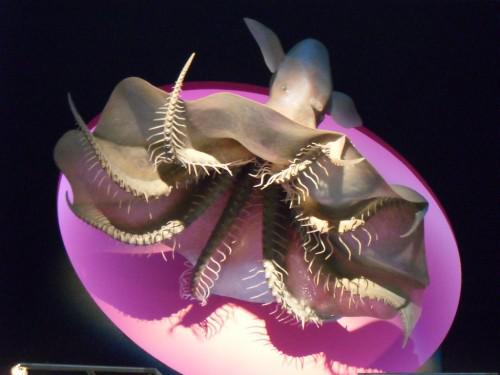
But the features do not end it. Here are a few.
Firstly, it has blue blood. This color is due to copper content in the blood.
Secondly, from the squid is the lowest among deep-sea cephalopods metabolic rate.
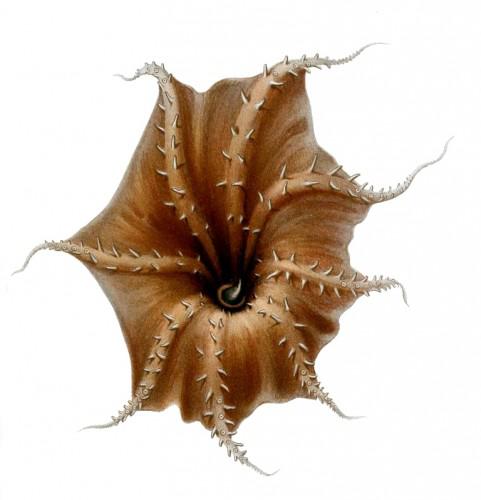
Thirdly, the density of the body because of its high content of ammonia in the tissues, substantially corresponds to the density of seawater. This allows you to maintain the buoyancy of the vampire and spend a minimal amount of energy in movement.
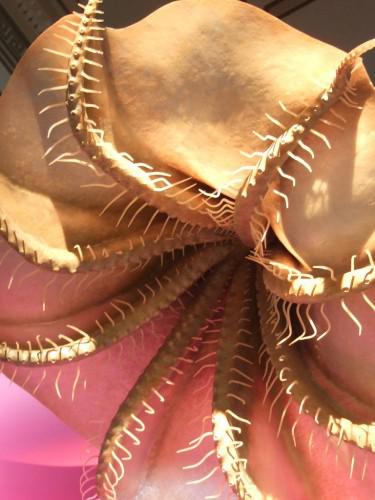
Fourth, at the vampire squid has another unusual defense strategy. It's called kontrillyuminatsiya. In order not to give out your location, it emits a bluish glow. This light blurs the outline of the animal, hiding it from view from below.
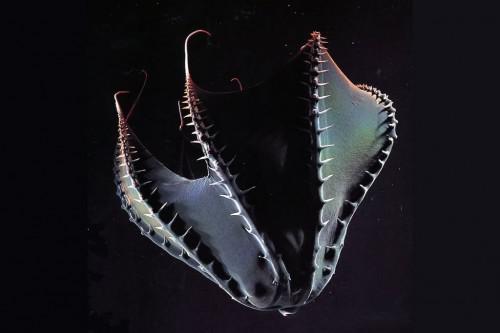
Fifth, he has no ink bag. Instead of ink it releases a glowing cloud of sticky mucus, which contains a lot of blue luminous balls. This light curtain helps to mislead the enemy and at this time to quickly retreat. But this method had squid in store for the most extreme cases, for the restoration of the mucus leaves a lot of energy.
Finally, in the attacks of predators, which is what the large deep-sea fishes, whales, sea lions and all those who are capable of deep dives, it takes "attitude pumpkin." Squid tentacles and turns inside out and close the membrane of the body. Thus, the show exhibited his needle and antennae, which look alarmingly. Remember I said that the inner surface has no photophores, so during such a posture his body becomes almost invisible. Visible only glowing tips of the tentacles, which are summarized above his head. This unusual posture removes the attack on the important parts of the body. The predator often bites the glowing tips. But it does not matter, they grow back. The main thing - to remain intact.
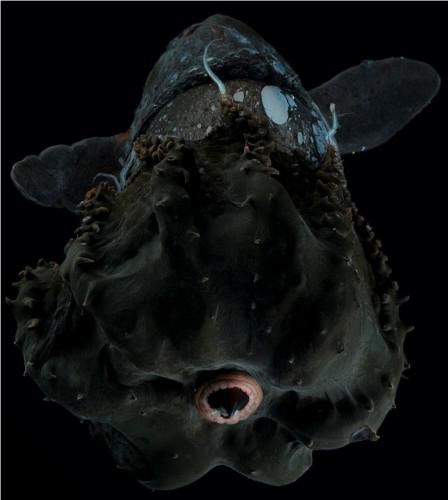
Because of the scarcity of habitat vampires feed on small crustaceans and cnidarians.
The process of breeding them as unusual. Chance meeting with the opposite sex is minimal, because these animals are not so much of their habitat and the area is huge. Therefore, the reproduction becomes a random event. But it is fixable. Females in the course of its development, adapt himself for a long time to keep the male spermatophores. After fertilization, the female lays a small number of large eggs and hatching them to 400 days (!!!) until the fry hatch. Then she dies.
Hatched Vampirchiki - a copy of their parents, only a very small, about 8 millimeters. They are transparent and have no webbing between the tentacles. They feed on organic remains that fall from the upper layers.
Juveniles clam passes three stages: in the first stage, they have one pair of fins on the 2nd - intermediate stage - there is a new pair, and the third - in adults - the first pair of degenerates and only the 2nd couple
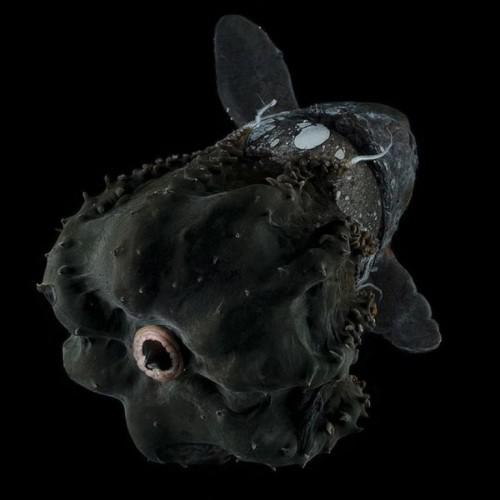
And finally a little accordionist movie, without which the theme would not be complete
That such an animal, consisting entirely of "peculiarities».
via Helga
Source:
Today I want to introduce you to one small cephalopods, wearing frightening name "vampire squid". For what it so to be honest, I still do not understand. This animal is unique in every way. Take, for what he has blue blood, and it can easily be at a depth of 400 to 1,000 meters, where oxygen content is minimal.

Vampire squid or a hellish vampire squid (lat. Vampyroteuthis infernalis) (Eng. Vampire Squid)

The discovery of this animal belongs to the German zoologist Karl Hun, I discovered it in 1903. This deep-water clam has common features with the octopus and squid. Initially, it wrongly attributed to the octopus. Although over time it became clear that it is necessary to allocate a separate unit, which was named Varpyromorhida.

In the area of its habitat no light penetrates. At this depth is a special habitat, which was called "the oxygen minimum zone." It is very low oxygen concentration. But the vampire squid conditions are quite comfortable. He can live with 3% concentration of oxygen in the water. In such a feat by any other animal can not.

Rostochkom vampire came out - just 15 centimeters, but argue that it can grow up to 30 centimeters. A couple of little "devil incarnate." Its gelatinous body is able to change color depending on the light. He may become black, dark purple, red, brown.

At the vampire squid has eight tentacles that are interconnected membranes. Each of them is covered with needles inside and mustache. Under certain circumstances, the squid uses them very skillfully. How? Learn dalshe.Na ends of tentacles arranged sucker.

In vampire squid unusual bulging eyes. Like skin, they can change their color depending on the light (in red or blue). Right chameleon deep sea world. The diameter of the eye is 2, 5 cm. When compared with the total length of the body, they are the large eyes in proportion to body size among all animals. They are hypersensitive and are able to discern the silhouettes of other animals, floating on top. And do it in almost total darkness is not so simple.

If you look closely, you'll see a pair of "ears". This fins, growing out of the side parts of the mantle. They are the main means of transportation in adults.

The connective tissue in the area of the tentacles are 2 bags, hiding sensitive velar flagella. These then are the true "tentacles" vampire, because they can stretch the farthest tentacles

Vampire squid can glow in the dark. His entire body surface is covered with photophores - bodies glow. They are small wheels, which increase at the base of the fins and at the ends of the tentacles. But on the inside of the membranes and they are not for a reason, which I'll discuss below.

Its glow he skillfully uses as a defense against attackers. Squid produces flashes of light that disorient the enemy. It can control the size of the light spots and the brightness of their glow.

But the features do not end it. Here are a few.
Firstly, it has blue blood. This color is due to copper content in the blood.
Secondly, from the squid is the lowest among deep-sea cephalopods metabolic rate.

Thirdly, the density of the body because of its high content of ammonia in the tissues, substantially corresponds to the density of seawater. This allows you to maintain the buoyancy of the vampire and spend a minimal amount of energy in movement.

Fourth, at the vampire squid has another unusual defense strategy. It's called kontrillyuminatsiya. In order not to give out your location, it emits a bluish glow. This light blurs the outline of the animal, hiding it from view from below.

Fifth, he has no ink bag. Instead of ink it releases a glowing cloud of sticky mucus, which contains a lot of blue luminous balls. This light curtain helps to mislead the enemy and at this time to quickly retreat. But this method had squid in store for the most extreme cases, for the restoration of the mucus leaves a lot of energy.
Finally, in the attacks of predators, which is what the large deep-sea fishes, whales, sea lions and all those who are capable of deep dives, it takes "attitude pumpkin." Squid tentacles and turns inside out and close the membrane of the body. Thus, the show exhibited his needle and antennae, which look alarmingly. Remember I said that the inner surface has no photophores, so during such a posture his body becomes almost invisible. Visible only glowing tips of the tentacles, which are summarized above his head. This unusual posture removes the attack on the important parts of the body. The predator often bites the glowing tips. But it does not matter, they grow back. The main thing - to remain intact.

Because of the scarcity of habitat vampires feed on small crustaceans and cnidarians.
The process of breeding them as unusual. Chance meeting with the opposite sex is minimal, because these animals are not so much of their habitat and the area is huge. Therefore, the reproduction becomes a random event. But it is fixable. Females in the course of its development, adapt himself for a long time to keep the male spermatophores. After fertilization, the female lays a small number of large eggs and hatching them to 400 days (!!!) until the fry hatch. Then she dies.
Hatched Vampirchiki - a copy of their parents, only a very small, about 8 millimeters. They are transparent and have no webbing between the tentacles. They feed on organic remains that fall from the upper layers.
Juveniles clam passes three stages: in the first stage, they have one pair of fins on the 2nd - intermediate stage - there is a new pair, and the third - in adults - the first pair of degenerates and only the 2nd couple

And finally a little accordionist movie, without which the theme would not be complete
That such an animal, consisting entirely of "peculiarities».
via Helga
Source:
